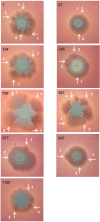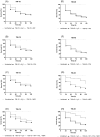Macrocolony of NDM-1 Producing Enterobacter hormaechei subsp. oharae Generates Subpopulations with Different Features Regarding the Response of Antimicrobial Agents and Biofilm Formation
- PMID: 31014001
- PMCID: PMC6631906
- DOI: 10.3390/pathogens8020049
Macrocolony of NDM-1 Producing Enterobacter hormaechei subsp. oharae Generates Subpopulations with Different Features Regarding the Response of Antimicrobial Agents and Biofilm Formation
Abstract
Enterobacter cloacae complex has been increasingly recognized as a nosocomial pathogen representing the third major Enterobacteriaceae species involved with infections. This study aims to evaluate virulence and antimicrobial susceptibility of subpopulations generated from macrocolonies of NDM-1 producing Enterobacter hormaechei clinical isolates. Biofilm was quantified using crystal violet method and fimbrial genes were investigated by PCR. Susceptibility of antimicrobials, alone and combined, was determined by minimum inhibitory concentration and checkerboard assays, respectively. Virulence and efficacy of antimicrobials were evaluated in Galleria mellonella larvae. Importantly, we verified that some subpopulations that originate from the same macrocolony present different biofilm production ability and distinct susceptibility to meropenem due to the loss of blaNDM-1 encoding plasmid. A more in-depth study was performed with the 798 macrocolony subpopulations. Type 3 fimbriae were straightly related with biofilm production; however, virulence in larvae was not statistically different among subpopulations. Triple combination with meropenem-rifampicin-polymyxin B showed in vitro synergistic effect against all subpopulations; while in vivo this treatment showed different efficacy rates for 798-1S and 798-4S subpopulations. The ability of multidrug resistant E. hormaechei isolates in generating bacterial subpopulations presenting different susceptible and virulence mechanisms are worrisome and may explain why these infections are hardly overcome.
Keywords: Enterobacter; Galleria mellonella; antimicrobial treatment; blaNDM-1; macrocolony biofilm.
Conflict of interest statement
The authors declare no conflicts of interest.
Figures





Similar articles
-
Species identification, antibiotic resistance, and virulence in Enterobacter cloacae complex clinical isolates from South Korea.Front Microbiol. 2023 Mar 23;14:1122691. doi: 10.3389/fmicb.2023.1122691. eCollection 2023. Front Microbiol. 2023. PMID: 37032871 Free PMC article.
-
Enterobacter hormaechei subsp. oharae subsp. nov., E. hormaechei subsp. hormaechei comb. nov., and E. hormaechei subsp. steigerwaltii subsp. nov., three new subspecies of clinical importance.J Clin Microbiol. 2005 Jul;43(7):3297-303. doi: 10.1128/JCM.43.7.3297-3303.2005. J Clin Microbiol. 2005. PMID: 16000451 Free PMC article.
-
Enhanced efficacy of imipenem-colistin combination therapy against multiple-drug-resistant Enterobacter cloacae: in vitro activity and a Galleria mellonella model.J Microbiol Immunol Infect. 2018 Feb;51(1):70-75. doi: 10.1016/j.jmii.2016.01.003. Epub 2016 Jan 29. J Microbiol Immunol Infect. 2018. PMID: 26906264
-
Cluster Differences in Antibiotic Resistance, Biofilm Formation, Mobility, and Virulence of Clinical Enterobacter cloacae Complex.Front Microbiol. 2022 Apr 6;13:814831. doi: 10.3389/fmicb.2022.814831. eCollection 2022. Front Microbiol. 2022. PMID: 35464993 Free PMC article.
-
Enterobacter cloacae complex: clinical impact and emerging antibiotic resistance.Future Microbiol. 2012 Jul;7(7):887-902. doi: 10.2217/fmb.12.61. Future Microbiol. 2012. PMID: 22827309 Review.
Cited by
-
Understanding blaNDM-1 gene regulation in CRKP infections: toward novel antimicrobial strategies for hospital-acquired pneumonia.Mol Med. 2024 Feb 23;30(1):29. doi: 10.1186/s10020-024-00794-y. Mol Med. 2024. PMID: 38395744 Free PMC article.
-
Presence and Role of the Type 3 Fimbria in the Adherence Capacity of Enterobacter hormaechei subsp. hoffmannii.Microorganisms. 2024 Jul 16;12(7):1441. doi: 10.3390/microorganisms12071441. Microorganisms. 2024. PMID: 39065209 Free PMC article.
-
Fighting biofilm: bacteriophages eliminate biofilm formed by multidrug-resistant Enterobacter hormaechei on urological catheters.Med Microbiol Immunol. 2025 Jul 3;214(1):33. doi: 10.1007/s00430-025-00844-0. Med Microbiol Immunol. 2025. PMID: 40608147 Free PMC article.
-
First documentation of a clinical multidrug-resistant Enterobacter chuandaensis ST2493 isolate co-harboring blaNDM-1 and two blaKPC-2 bearing plasmids.Sci Rep. 2024 Nov 5;14(1):26817. doi: 10.1038/s41598-024-78163-2. Sci Rep. 2024. PMID: 39500966 Free PMC article.
-
The membrane depolarization and increase intracellular calcium level produced by silver nanoclusters are responsible for bacterial death.Sci Rep. 2021 Nov 3;11(1):21557. doi: 10.1038/s41598-021-00545-7. Sci Rep. 2021. PMID: 34732754 Free PMC article.
References
-
- Chavda K.D., Chen L., Fouts D.E., Sutton G., Brinkac L., Jenkins S.G., Bonomo R.A., Adams M.D., Kreiswirth B.N. Comprehensive Genome Analysis of Carbapenemase-Producing Enterobacter spp.: New Insights into Phylogeny, Population Structure, and Resistance Mechanisms. MBio. 2016;7 doi: 10.1128/mBio.02093-16. - DOI - PMC - PubMed
Grants and funding
- 1871-25511/13-4/Fundação de Amparo à Pesquisa do Estado do Rio Grande do Sul
- 408578/2013-0/Conselho Nacional de Desenvolvimento Científico e Tecnológico
- 443150/2014-1/Conselho Nacional de Desenvolvimento Científico e Tecnológico
- doctoral fellowship/Coordenação de Aperfeiçoamento de Pessoal de Nível Superior
- 465718/2014-0/Instituto Nacional de Ciência e Tecnologia
LinkOut - more resources
Full Text Sources

